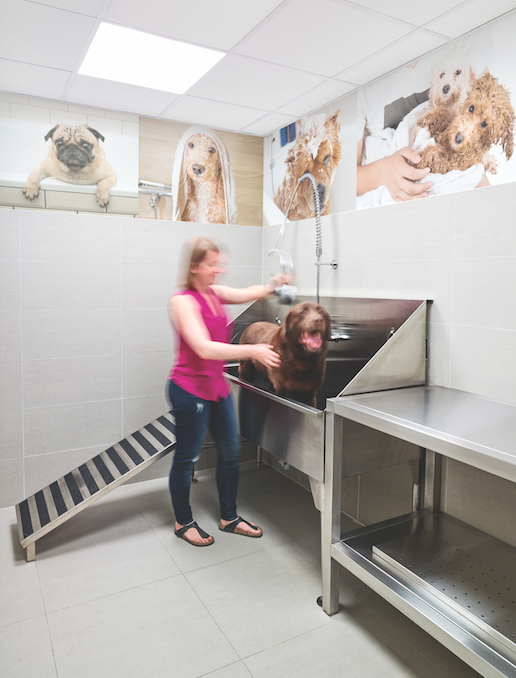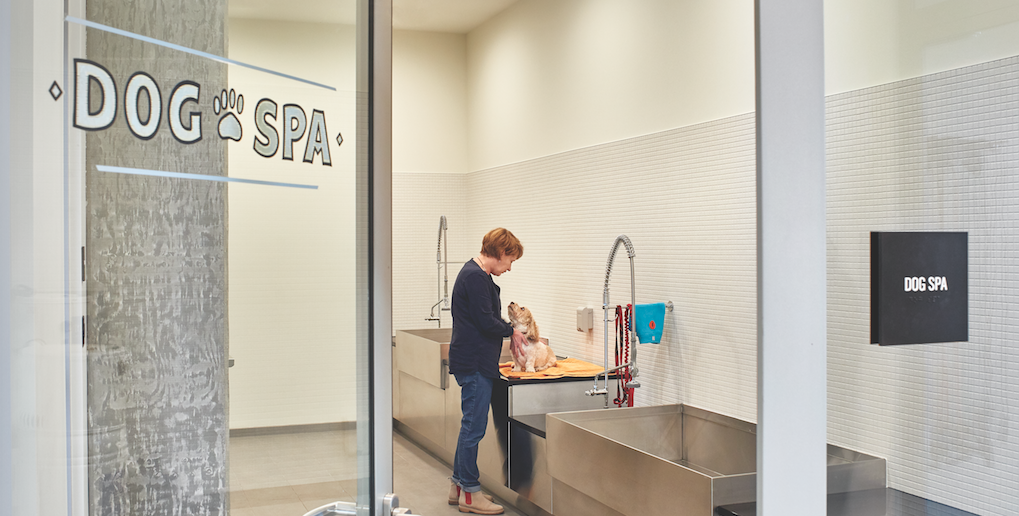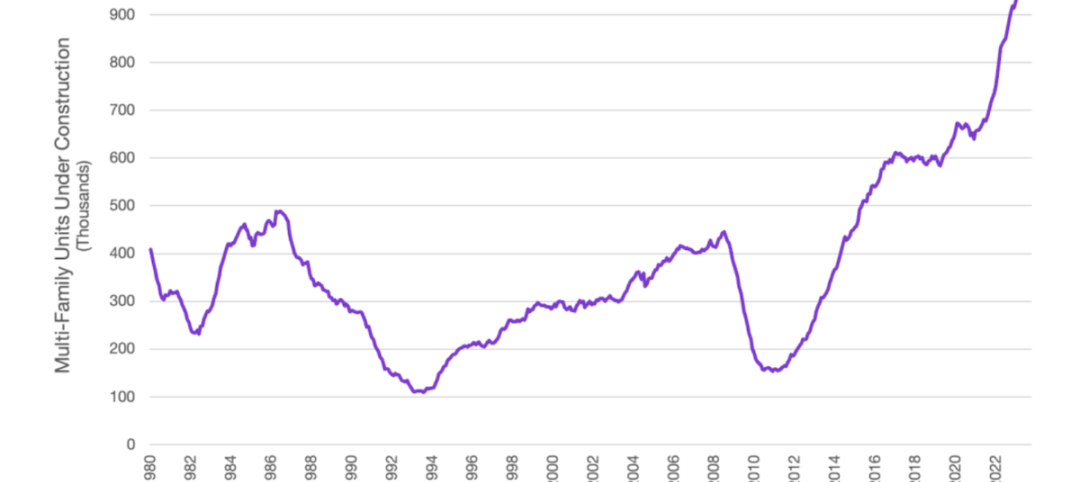There’s a construction boomlet under way in dog-washing facilities at U.S. and Canadian apartment and condominium communities.
Half of U.S. dog owners live in the 25 largest U.S. metro areas, where dog-focused amenities are common at apartment and condominium properties. More than half (55.2%) of respondents to this publication’s 2017 “Amenities Survey” said they had installed a dog-wash spa in a multifamily project.
Dog ownership has risen 29% in the past decade, claims pet-food market researcher Packaged Facts. According to the American Veterinary Medical Association, singles and renters make up the fastest-growing group of new dog owners.
Dog-washing stations provide renters and condo owners with an on-site amenity that’s a lot more practical than bathing a pup in a ceramic or fiberglass tub intended for humans. “Most tubs in multifamily building units have a conventional kitchen sink drain that can easily clog with dog fur, leading to maintenance and hygiene issues,” said Gary Sherman, Founder/CEO, Evolution Dog Wash Company, Los Angeles, who has installed about 50 such systems in residential buildings in North America.
The cost of installing a dog wash station can run from $3,500 to $8,000 per tub with all equipment, said Dan Hembree, President, Hemcor Construction, Cary, N.C. Some multifamily communities offer it as a free amenity; others charge a one-time fee or a per-use or monthly fee.
We asked four experienced professionals about installing these amenities. Here’s what they recommended.
Select a convenient location. Our experts recommend locating the dog-wash stations close to elevators, with easy access to the exterior, if possible.
The dog spa at the 41-story Quartz at City Place condominium tower in downtown Toronto is adjacent to a small outside dog park, which is accessible through a side entrance. “Residents can whisk their muddy dogs inside quickly and without tracking them through the main lobby area,” said Dominic De Freitas, ARIDO, IDC, NCIDQ, Vice President of Residential Development at interior design firm figure3, Toronto.
Size it right. Dog-washing spaces range in size from 100 sf to more than 1,000. The most basic house a utility sink and a few prefabricated stainless-steel tubs, said architect Brian Romanelli, Associate, Solomon Cordwell Buenz, Chicago. Larger, more sophisticated dog spas feature custom-designed systems with wall-mounted blow dryers and grooming tables. Rooms should be adequately sized to give dog owners easy access to all equipment, he said.
Connect the space to other pet amenities. At AMLI Residential’s new AMLI Arc luxury apartment tower in downtown Seattle—a city where pets far outnumber children—the “Canine Social Club” in the 12th-floor amenities space has a dog spa with two self-serve washing areas and a grooming station with a hydraulic lift. The space is adjacent to an indoor-outdoor pet lounge that’s connected to a semi-outdoor dog run with artificial turf.

The dog-washing station at the Quartz Condos at Concord CityPlace in Toronto. Photo: Steve Tsai
“We were able to create a large, playful space that benefits both the residents and their pet family members,” said Camilla Watson, Interior Designer, ZGF Architects, Seattle.
Where there are multiple tubs, position the water valves on opposite sides of the tubs, so that two dogs aren’t facing each other while bathing. “Helps avoid conflict,” said Hembree.
Provide a ramp for the dogs, especially larger species, to get into the tub. “It can be a strain to hoist and control a rambunctious pup who isn’t crazy about getting wet and soapy,” said Sherman.
Never ignore aesthetics. Developers want to avoid making dog-grooming spaces feel like utilitarian, back-of-house facilities, said De Freitas. “There’s more of a focus to create a spa-like environment, especially in purpose-built rental projects,” he said.
At the Sinclair, a 35-story, 390-unit luxury apartment tower in Chicago’s Gold Coast neighborhood, the finishes in the dog spa are consistent with the project’s other amenity spaces. “Tile floors, wainscoted walls, custom decorative lighting, and natural-toned finishes were incorporated throughout the space” as requested by the developer (Fifield Companies), said Romanelli.
Pay close attention to maintenance, air quality, and noise. Select wall and floor finishes that are easy to clean and resistant to moisture, including slip-resistant floors with a dog-friendly coating, said Romanelli. “It’s also important to provide adequate ventilation to ensure that no strong odors leave the room.” Sound-absorbing ceiling tiles and other acoustical treatments can prevent boisterous barks from penetrating into adjacent spaces.
Make sure electrical outlets are designed to accommodate hair dryers—in some cases, a 220-volt receptacle may be needed. Install wall-mounted hair dryers within easy reach of human users. If necessary to avoid accessibility problems, have the manufacturer weld custom brackets underneath the grooming table, said Hembree.
Specify non-slip grooming mats on drying tables. “A good rubber mat allows the wet animal to stand comfortably without fear of slipping,” said Hembree.
Look into built-in storage. The dog spa at AMLI Arc has open bins for residents to store their supplies short-term and lockers for long-term storage, said Watson.
Build community. Pet owners gravitate toward other pet owners, and dog-washing stations can serve as social connectors in multifamily communities. “We’re seeing a big push to create a community-like environment within a building,” said De Freitas. “As these spaces continue to get larger, they’re inevitably going to become more social as well.”
At a new apartment building De Freitas is designing in downtown Toronto, the glass-fronted dog-wash room will be clearly visible from the main lobby. “We want the lobby to feel active and conducive to community,” he said. “So many people in these buildings have dogs. We’re trying to celebrate that, instead of hiding it.”
Prepare for future enhancements. De Freitas predicts that professional dog-grooming services, such as nail trimming and shearing, will become more common as developers and property managers test new and more elaborate pooch-friendly services.
Related Stories
MFPRO+ News | Dec 7, 2023
7 key predictions for the 2024 multifamily rental housing market
2024 will be the strongest year for new apartment construction in decades, says Apartment List's chief economist.
Codes and Standards | Dec 7, 2023
New York City aims to spur construction of more accessory dwelling units (ADUs)
To address a serious housing shortage, New York City is trying to get more homeowners to build accessory dwelling units (ADUs). The city recently unveiled a program that offers owners of single-family homes up to nearly $400,000 to construct an apartment on their property.
MFPRO+ News | Dec 5, 2023
DOE's Zero Energy Ready Home Multifamily Version 2 released
The U.S. Department of Energy has released Zero Energy Ready Home Multifamily Version 2. The latest version of the certification program increases energy efficiency and performance levels, adds electric readiness, and makes compliance pathways and the certification process more consistent with the ENERGY STAR Multifamily New Construction (ESMFNC) program.
Transit Facilities | Dec 4, 2023
6 guideposts for cities to create equitable transit-oriented developments
Austin, Texas, has developed an ETOD Policy Toolkit Study to make transit-oriented developments more equitable for current and future residents and businesses.
Multifamily Housing | Nov 30, 2023
A lasting housing impact: Gen-Z redefines multifamily living
Nathan Casteel, Design Leader, DLR Group, details what sets an apartment community apart for younger generations.
Products and Materials | Nov 30, 2023
Top building products for November 2023
BD+C Editors break down 15 of the top building products this month, from horizontal sliding windows to discreet indoor air infusers.
Engineers | Nov 27, 2023
Kimley-Horn eliminates the guesswork of electric vehicle charger site selection
Private businesses and governments can now choose their new electric vehicle (EV) charger locations with data-driven precision. Kimley-Horn, the national engineering, planning, and design consulting firm, today launched TREDLite EV, a cloud-based tool that helps organizations develop and optimize their EV charger deployment strategies based on the organization’s unique priorities.
MFPRO+ Blog | Nov 27, 2023
7 ways multifamily designers can promote wellness in urban communities
Shepley Bulfinch's Natalie Shutt-Banks, AIA, identifies design elements that multifamily developers can use to maximize space while creating a positive impact on residents and the planet
MFPRO+ New Projects | Nov 21, 2023
An 'eco-obsessed' multifamily housing project takes advantage of downtown Austin’s small lots
In downtown Austin, Tex., architecture firm McKinney York says it built Capitol Quarters to be “eco-obsessed, not just eco-minded.” With airtight walls, better insulation, and super-efficient VRF (variable refrigerant flow) systems, Capitol Quarters uses 30% less energy than other living spaces in Austin, according to a statement from McKinney York.
MFPRO+ News | Nov 21, 2023
California building electrification laws could prompt more evictions and rent increases
California laws requiring apartment owners to ditch appliances that use fossil fuels could prompt more evictions and rent increases in the state, according to a report from the nonprofit Strategic Actions for a Just Economy. The law could spur more evictions if landlords undertake major renovations to comply with the electrification rule.

















